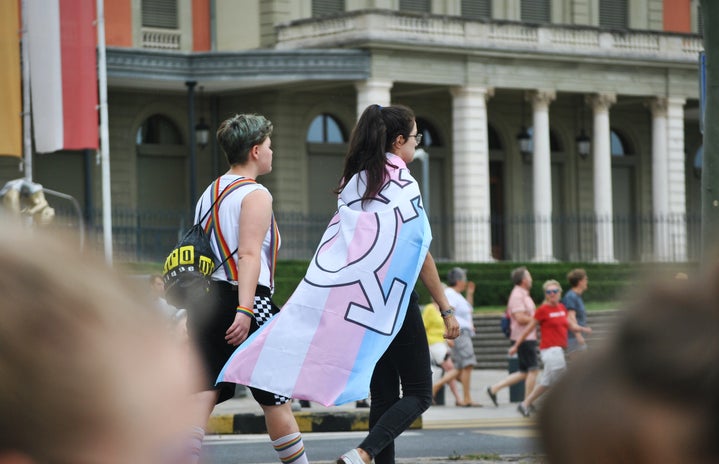Transgender people face prejudices, doubts, fears and it was only in 2019 that the World Health Organization (WHO) removed transsexuality from the list of mental illnesses. Besides that, according to data from the National LGBT Union, the average life expectancy of a trans person is only 35 years.
With the COVID-19 pandemic, a transgender civil society organization in Indonesia called Sanggar Swara conducted a survey that showed that more than 640 trans people in Jakarta lost their jobs and were unable to support themselves. Moreover, when we talk about trans women, this can be even more worrying, as they deal with transphobia and patriarchy.
This information shows the great difficulty that this minority has in all aspects of life, and if you don´t know they are people who have struggled since the past for their freedoms and rights.
Get to know six of them, who had her important achievements erased from history and away of our school classes:
- Marsha P. Johnson (1945 – 1992)
-
Transgender black woman, drag queen, activist, and pioneer in the LGBTQI+ rights movement, Marsha has spent most of her life helping others. Her activism, generosity, and strength to battle what she believed help and inspires thousands of young people around the world.
After finishing high school in New Jersey, she went to New York in 1963 with just a bag of clothes and 15 dollars in her hand. Only six years later of her arrival, Marsha was already on the front lines and was one of the main personalities of the Stonewall Rebellion in 1969, which was a series of demonstrations and fights in front of the Stonewall bar – one of the only places that people in the community frequented, since the owners of the place paid bribes to homophobic policemen. On June 28, 1969, four officers invaded the place and wanted to take everyone to the police station, but more than two thousand people were around the bar and shouted “gay power!”.
Marsha also created STAR (Street Travestite Action Revolutionaries) with her friend Sylvia Rivera, who was also a transsexual drag queen, to support young transsexuals and homosexuals who had been expelled from home.
Even accumulating big achievements, the giant marginalization and the constant struggle to recognize her existence generated great scars in the woman, who constantly suffered from mental health problems. In 1992 at age 42, Johnson’s body was found on the Hudson River in New York, and the case was pointed out as suicide. Nevertheless, his close friends did not believe and after efforts by activist Mariah Lopez, the police reopened the case in 2012. Marsha’s tragic ending shows how violence against transgender people has always been common.
Her life also became a documentary released on Netflix in 2017:
- Dora Richter (1891 – 1933)
-
Dora was the first person to be subjected to gender transition surgeries in history. At the age of six, she tried to pluck her penis with a tourniquet and since she was young, liked to wear clothes considered feminine, presenting herself as a woman. Therefore, her family allowed her to live in a feminine way. She worked as a barmaid in Berlin hotels and once was arrested for “dressing up as a woman” when was released by a progressive judge who referred her to be taken care of by Magnus Hirschfeld, founder of the Scientific-Humanitarian Committee, defender of the rights of homosexuals and transgender people.
Dora started working as a domestic worker at the Institute for Sexual Research, one of the only places that transvestites or trans women could work. In 1922, as part of a study, she underwent an orchiectomy, surgery to remove the testicles, and months later, she received an artificial vagina.
In May 1933, the Nazis seized power in Germany and it is believed that Dora was the victim of Nazi students who set Magnus’s sexual institute on fire. At the time, state officials burned all records, including those about the trans woman, who was 42 years old when she died.
- Lili Elbe (1882 – 1931)
-
Behind the movie “The Danish Girl”, which had four nominations and an Oscar award in 2016, there is the story of Lili Elbe, who married the painter Gerda Wegener when she hadn’t discovered herself a trans woman yet. In 1926, she was an instructive and depressed artist. One day, Gerda needed a model for her painting and realized that her husband had fine and delicate features on her face. She put on clothes that were seen as feminine, felt comfortable, and that depressed person found Lili, an expansive and free model, in himself. In her diary, she wrote, “I can’t deny it, it may sound weird, but I felt good in the softness of women’s clothes”.
In the early 1930s, with Gerda’s support, Lili moved to Germany to perform surgeries to remove the testicles and the penis under the supervision of Magnus Hirschfeld. The case became news in the country and because of this, a Danish court invalidated the marriage of Gerda and Lili. They were married from 1904 to 1930 when she had permission to change her name in documents.
The surgeon Kurt Warnekros performed several operations in Lili but she still had the dream of having a family. Like this, the doctor planned to complete the process by having a uterus transplant and the construction of a vagina, but the woman did not support it and so she died a few days before age 50.
- Lucy Anderson Hicks (1886 – 1954)
-
Lucy, a trans and black woman, used to wear a dress to school and asked her mother to take her to a doctor who “allowed” her life as a woman. At the age of 15, Lucy left home and after six years married her first husband. The union lasted nine years and as she worked as a maid, saved her salary, and opened a brothel in Oxnard, California. However, the police soon banned the venture and arrested Lucy for the illegal sale of alcohol, but she was fast released by protests from the population and the payment of her bail by a banker.
Just married to her second husband, Reuben Anderson, Lucy had to go through medical exams because an outbreak of Sexually Transmitted Diseases was happening and she owned a brothel. The doctor pointed in his reports that Lucy was a man, which generated a great judicial process since she was accused of falsehood and had her marriage annulled. “I challenge any doctor in the world to prove that I am not a woman,” said Lucy when a court contested her gender. To reporters, she said, “I have lived, dressed, acted just what I am, a woman”.
The court sentenced Lucy and her husband to 10 years in prison because the government concluded that she was illegally receiving assignment checks as the wife of a member of the US Army, in addition to having forbidden her to wear “women’s clothing”. After being released, Lucy was banned from returning to Oxnard, then moved to Los Angeles with her husband, where she lived until her death in 1954 at the age of 68.
- Virginia Prince (1912 – 2009)
-
Virginia Prince was fundamental in understanding the transgender movement about gender identity. In his early years, Prince remembered showing interest in the expression of the opposite sex. At the age of 12, she liked high heels, stole dresses from her mother and sister, and soon started to dress up and walk the streets of Los Angeles in hiding.
While Prince was having his marriage to Dorothy Shepherd in crisis because she hid her cross-dressing, some transgender people were gaining fame in European countries, like Christine Jorgensen who was in Denmark for her orchiectomy (removal of testicles). This impacted Virginia’s life, because she had an “inner feminine”, as she said, but did not feel dysphoria with her genitalia. Therefore, she studied books about the separation of the concepts of sex and gender by feminist theorists and realized that her “inner feminine” was not related to the reproductive system nor her sexuality, since she was a lesbian (contrary to what the press and medicine said), but with gender.
In addition to producing scientific articles in the field of sexology, in 1960, Virginia founded the magazine Transvestia, which could be hidden in a pocket, and was aimed at the transvestite community. Then, started to include content about the broader trans community. In the magazine, people could openly write about their experiences, challenges, and successes. Subscribers could relate to each other through articles, advertisements, and writing for publishers. Prince died at 97.
- Extra: Besides these incredible women, many make history every day
-
The “Pose” series, as its cast has the largest number of trans in history, such as Indya Moore and MJ Rodriguez, with a script that celebrates diversity by telling stories of trans, black and Latin women, make history for the community.
Moreover, in this year’s elections in Brazil, for example, Erika Hilton was the first black trans woman elected as a city councilor in the city of São Paulo. In addition to three transvestites in the Municipal Legislature. In all places, these women struggle to gain space, and each step is very important.
Only in 2019, trans people were murdered 331 times worldwide, according to the Trans Murder Monitoring (TMM) report. Brazil is the country that kills the most transgender in the world and in 2020, even with the pandemic, this number increased 41% compared to the previous year, going from 124 to 175 trans dead women, data presented in the dossier of the National Association of Transvestites and Transsexuals. Therefore, each existence tells a story of people who do not go through an easy life.
——————————
This article was edited by Nicoly Bastos.
Liked this type of content? Check Her Campus Casper Libero home page for more.


